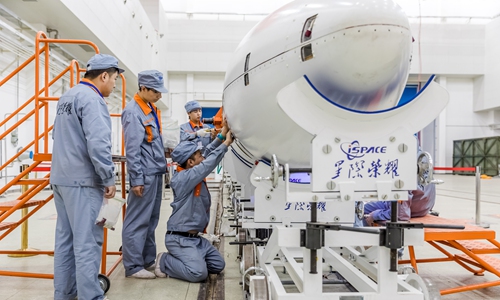Chinese private rocket firm iSpace announces $174m new financing
Source: Global Times Published: 2020/8/25 20:54:26

iSpace engineers prepare the company's first orbital carrier rocket which was planned to be launched from the Jiuquan Satellite Launch Center in Northwest China's Gansu Province in July 2019 . Photo: Courtesy of iSpace
Private rocket firm iSpace, dubbed China's answer to SpaceX, announced on Tuesday the completion of 1.2 billion yuan ($174 million) in Series B financing, a record for a single round of financing in the domestic commercial aerospace sector.
The investment was led by Beijing Financial Street Capital Operation Center, with funding also coming from CICC Alpha, Taizhonghe Capital, Sequoia Capital China and others.
This round of financing will be mainly used for the research and development (R&D) of the firm's SQX series rockets, the development of its JD series reusable liquid oxygen methane engines, and professional training, according to a statement iSpace sent to the Global Times Tuesday.
The commercial space start-up is scheduled to launch its second SQX series rocket into orbit in October from the Jiuquan Satellite Launch Center in Northwest China's Gansu Province.
The company's carrier rocket successfully sent satellites into orbit from the Jiuquan center in 2019, a milestone for China's commercial space industry as it became the first private space firm to do so after two earlier failures by leading rocket start-ups OneSpace and LandSpace.
Its self-developed reusable liquid oxygen-methane engine JD-1, the first of its kind and a breakthrough in vertical landing rocket technology, has completed a key secondary start test.
Yao Bowen, a vice president of iSpace, told the Global Times that iSpace will accelerate its R&D work. He said the company would probably be able to achieve manned space flight by about 2025.
In September 2018, iSpace sent three satellites into sub-orbit using its carrier rocket, the first private-sector satellite launch in China.
Sub-orbital rockets fly at altitudes of more than 100 kilometers before falling back to Earth.
Posted in: COMPANIES